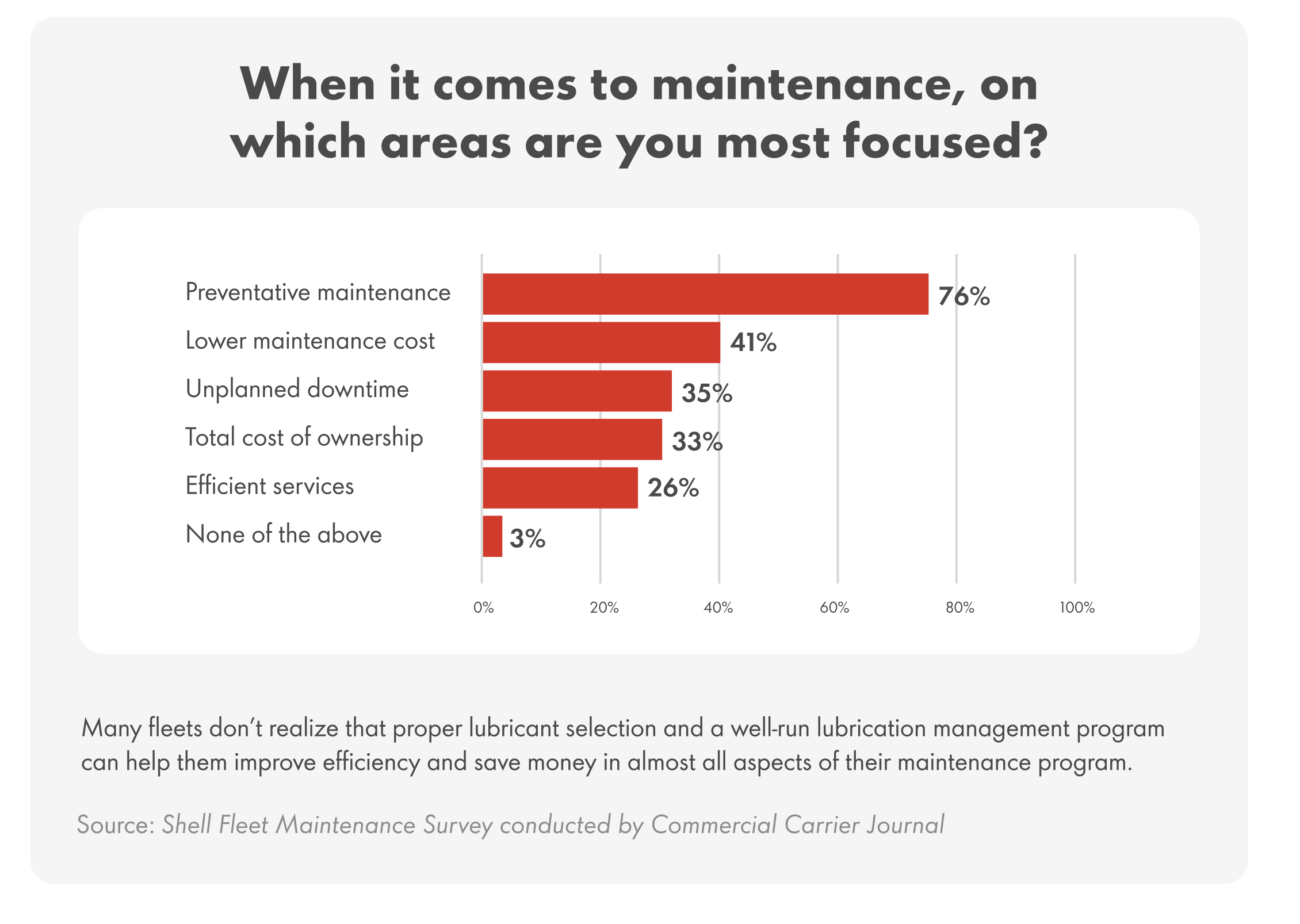
As fleets face flat revenues and double-digit cost increases, there’s never been a better time to look at the role lubricants play in total cost of ownership.
Fleet repair and maintenance costs rose by 12 percent to an industry average of $0.196 per mile in 2022. That’s on top of an 18.2 percent increase in 2021, according to the American Transportation Research Institute. With the cost of labor and new equipment also on the rise – and freight volumes and rates stagnant – savvy fleets are looking at ways to reduce costs and improve their bottom lines.
Maintenance spending typically represents nearly 10 percent of total operating costs, so it’s not surprising that many fleets look at lubricants as an easy way to cut costs. "Buying less expensive oils and greases may present initial cost savings, but the adverse affect on vehicles can end up costing more in the long run," says Tom Mueller, Shell general manager of Commercial Road Transport Lubricants.
A better approach is to choose competitively priced, high- quality lubricants that deliver excellent equipment protection and, in doing so, can help deliver cost savings. Shell Lubricant Solutions partners with customers to help improve the cost-efficiency of their fleets both in the short and long-term by focusing on two key areas.
1. Selecting the right lubricants helps fleets achieve maximum wear protection, longer oil drain intervals and enhanced fuel economy.
2. Upgrading fleets’ lubrication management program reduces lubricant consumption and maintenance and operating costs.
"Buying less expensive oils and greases may present initial cost savings, but the adverse affect on vehicles can end up costing more in the long run.
Tom Mueller, Shell general manager of Commercial Road Transport Lubricants
1. Step One: Select the Right Lubricants
Selecting the correct lubricants is a critical first step in improving productivity and realizing significant total cost of ownership savings. (TCO also includes costs related to lost productivity from unplanned vehicle downtime.) A quality engine oil should do more than just lubricate moving parts and prevent wear; it needs to neutralize natural acid by- products of engine combustion to avoid corrosion and minimize deposit formations in engines.
Fleets should also consider the benefits of low-viscosity heavy-duty diesel engine oils. These oils deliver the same wear protection and oil life as their thicker counterparts, but with improved fuel economy.
Another important consideration is the use of synthetic oils. Because they command a higher price, many fleets only use synthetic oils for vehicles if mandated by the preventive maintenance schedule or if strictly recommended by the OEM. But high-quality synthetic engine oils such as Shell Rotella T6 10W-30 can deliver good value because they maintain performance even in the presence of contaminants and by-products, Mueller says. High-quality synthetic oils can also minimize downtime from more frequent oil changes, maintenance and even component failures caused by lower-quality oil.
Take this example: Truck A runs a conventional 15W-40 at 20,000- mile drain intervals. Truck B runs a full synthetic 5W-40 at 60,000- mile drain intervals. Both trucks run 120,000 miles per year and require 15 gallons of oil per oil change. That means Truck A will be off the road for service six times per year using 90 gallons of oil, and Truck B will be off the road two times per year using only 30 gallons of oil.
"When you add improved fuel economy, reduced downtime and longer engine life, the savings add up," Mueller says. "That means a lower-viscosity synthetic engine oil might appear to be a bigger upfront investment, but it pays off down the road."
Synthetic oils – a solid investment
Shell’s Rotella T6 10W-30 offers extreme temperature protection in hot conditions as well as improved cold start performance. With a pour point of -49 °F/-45 °C, the oil is still able to reach critical engine parts in the coldest operating temperatures.
The low-ash formulation offers emission system compatibility and facilitates lower oil consumption, increased protection against oxidation and improved corrosion control. Shell Rotella T6 10W-30 can be used in place of a 15W-40 engine oil in most instances, and it delivers 2 percent improved fuel economy in addition to its other benefits.
2. Step Two: Develop an Effective Lubricant Management Program
"We conduct an in-depth analysis of the facility including how fluids are stored and dispensed," Mueller says. The analysis also looks for correct application, whether fleets can reduce the number of fluids they use, and whether they are meeting all OEM specifications.

This can be especially valuable for fleets operating a mix of equipment makes and types. They may think they have no choice but to carry various fluid types, but a consultation may help them find fluids that are the correct choice across all platforms, Mueller says.
Oil analysis is another valuable tool to help fleets better manage their vehicle health. Regularly examining the characteristics of oil tells a lot about overall oil health and can uncover engine issues. "This can highlight problems early and prevent downtime and costly repairs," Mueller says.
As fleets continually look to reduce costs and improve productivity, the importance of partnering with a top-tier lubricant supplier cannot be overstated. Selecting the right lubricants for your operation and looking for ways to improve your maintenance processes can go a long way toward lowering your total cost of ownership. “And that drops right to the bottom line,” Mueller says.


